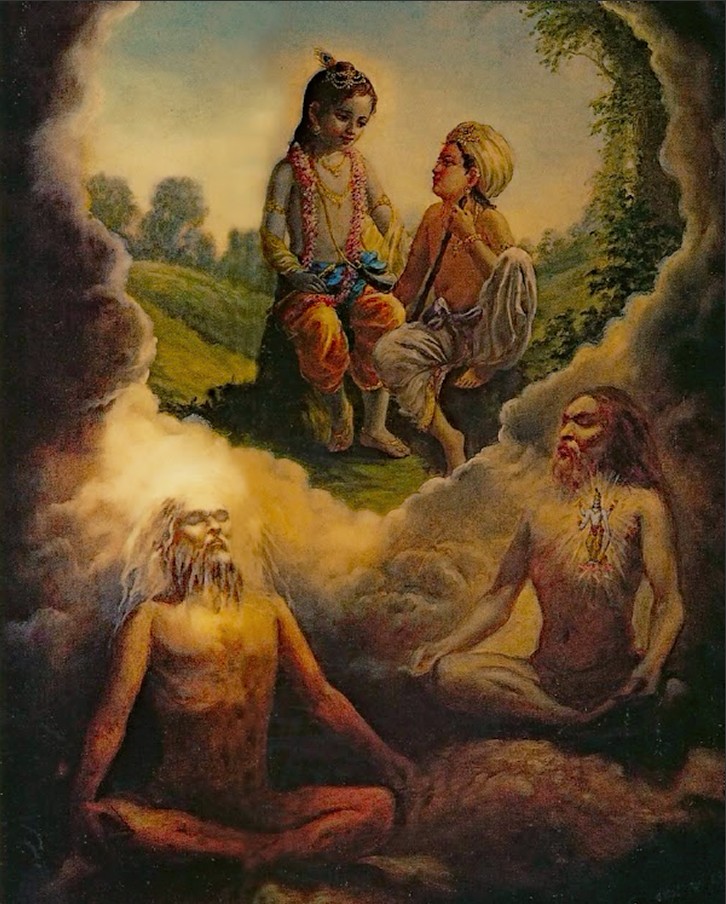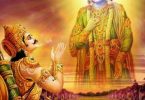Q. Then, there is also the conception of the Brahman. Apparently there are three different conceptions – the prakriti, the Purusha and the impersonal Form. Then there are three different bhagavan realizations – Brahman realizations, Paramatma realization and finally Bhagavan Realization. Then there are also statements made that the Supreme Lord is Krishna and that He is a person. It’s a mistake, nay a sin to conceive of Krishna as being formless. I wonder if these statements accurately reflect the truth, or is truth something else entirely?
Answer by Romapada Swami: Sanskrit is a very rich and highly context-sensitive language. In Digest 191 we discussed how the word ‘atma’ could denote many different ideas depending on the context of usage. In the same way, the word ‘Brahman’ also carries multiple meanings. This may prove confounding for a beginning student, but to those who are trained and have grasped the overall message of Vedas, the meaning becomes apparent with reference to the context.
“Brahman” actually denotes something that is “very great” – this is the literal meaning of the word.
Generally ‘brahman’ is used to indicate the opposite of matter, to indicate transcendence or spiritual reality. This idea is explained in BG 4.24. Krishna is the Supreme Spirit and the rays of His transcendental body is called ‘brahmajyoti’ or spiritual effulgence. Everything that exists is situated in the ‘brahmajyoti’ and because everything is an emanation from Krishna, they can be referred to as ‘brahman’ *in relation to Krishna*, but when they are covered by illusion or disconnected due to the spirit of sense-gratification, it becomes ‘material’. When matter is once again dovetailed in service to Supreme, it regains its spiritual quality. This is the meaning of the Vedic aphorism “sarvam khalv idam brahma” – “everything rests in and is sustained by Brahman, there is nothing apart from Brahman”.
The living entity (jivatma) is also called brahman – indicating the idea that we are all spiritual entities. This is the import of “aham brahmasmi” which indicates “I am spirit, different from false identification with the body.” The Supreme Lord is also brahman, but He is distinguished as “Parabrahman” or the “Supreme Brahman”. (Cf. BG 8.3)
Quite often, ‘brahman’ is used to indicate the “brahmajyoti” or all pervading spiritual effulgence emanating from the body of Lord Krishna. Krishna states that He is the basis or resting place of this impersonal brahman. (BG 14.27)
The total material substance, known as mahat-tattva is also sometimes called brahman – this idea is explained in BG 14.3. Material nature, which constitutes of 24 elements beginning with earth, water, fire, air is referred to therein as ‘mahad brahma’ or ‘great brahman’, because it is an emanation from the Supreme Spirit. The Supreme Lord impregnates this mahat-tattva and causes the birth of living entities into material nature.
Thus brahman could indicate (1) the living entity (purusha), or (2) the total material energy (prakriti), or (3) the impersonal brahmajyoti. It could also be used in the sense of that which is ‘spiritual’ or ‘transcendental’, and also as an indirect address to the Supreme Lord (just as one might use a pronoun to indicate a person!) The most common usage, however, is in reference to the all-pervading brahma-jyoti which is the impersonal realization of the Supreme.
You have mentioned about the three levels of bhagavan realization – more accurately, these are the three levels of realizing the Absolute Truth, one of which is bhagavan realization, which is the final word or summum bonum.
Just as a person who sees a hill from a great distance may get a hazy picture of a massive object, but as he comes closer he is able to recognize its features more distinctly and when he actually enters the hill, he sees the beauty and variegatedness of its flora and fauna and inhabitants. Similarly, a beginning student of transcendence without guidance from a realized devotee can reach up to the impersonal feature of the Supreme Absolute Truth, but with further advancement they can progressively realize the Paramatma feature and finally the bhagavan feature, i.e. realizing the Supreme as a Person. It is not an offense for a beginning student, who has no information about Krishna, to consider Brahman as the Supreme reality – as in the case of Sukadeva Goswami or the four Kumaras (see Digest 210). But those who purposefully deride the form of Krishna to be a material product and try to place the Brahman feature as superior to Krishna’s transcendental form commit an offense, as confirmed in BG 9.11.
I hope this brings you greater clarity on this subject.







